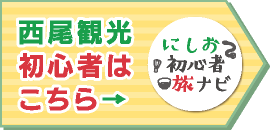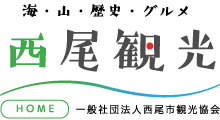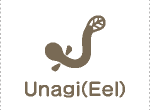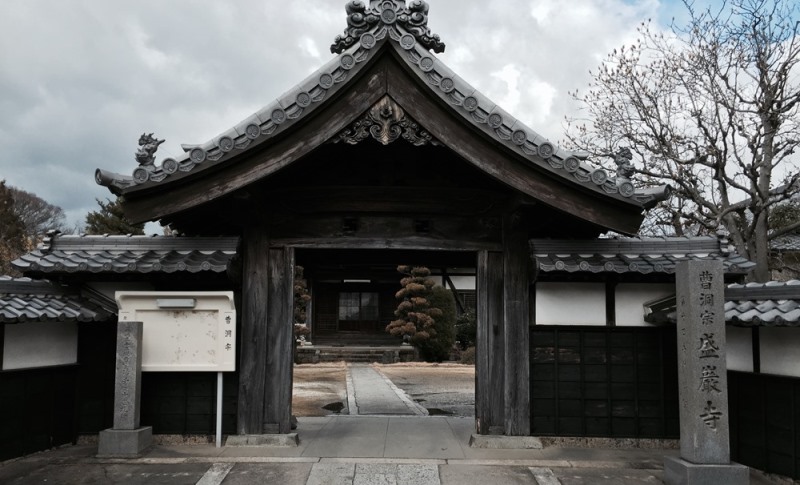Seiganji Temple (Soto sect)
Ogyu-Matsudaira clan family temple (“bodhi temple”).
Sodoshu Kyushuzan Seiganji Temple
 Main temple gate
Main temple gateAddress 70 Baba-cho Nishio-City TEL/FAX 0563-57-5513/0563-54-2143 Foundation Tensho 18(1590) in Kozuke Province in the Nawa Domain (currently Gunma Prefecture) Founder The 6th of the Ogyu-Matsudaira clan, Lord Ienori Chief Priest Sosenji (Edo) 8th-generation Denei Daiosho Principal Image Sho Kanzeon Bosatsu (Sacred Avalokitesvara) statue and the interior of Buddhist statues by Gyoki Bosatsu artwork
Ogyu-Matsudaira clan and Seiganji Temple
After its founding by Lord Ienori, the 6th of the Ogyu-Matsudaira clan, the Seiganji Temple was relocated every time the lord was transferred to a different territory. In Meiwa 1 (1764), the 11th head of the clan Lord Norisuke was transferred from the Yamagata Domain in Dewa Province to the Nishio Domain, which became the 12th and final location of the temple. The number of relocations shows the depth of the bond between this temple and the Ogyu-Matsudaira clan. The temple, built over the course of seven years, was destroyed by fire the year after completion leaving only the main temple gate, but was immediately rebuilt. The current main temple was renovated in Taisho 8 (1919).
The Ogyu-Matsudaira clan are a prestigious line of lords who were appointed as various cabinet officials of the Tokugawa shogunate, such as the keeper of the Osaka Castle, Kyoto Deputy, and Senior Councillor. The tombstone of Lord Noriyasu (the 14th head of the clan) and his wife and a cenotaph praising his virtue are located within the temple grounds. Additionally, the Buddhist memorial tablets of Ogyu-Matsudaira clan founding ancestor Lord Norimoto, the 2nd head of the clan Lord Norimasa, the 5th head of the clan Lord Masanori, the 6th head of the clean Lord Ienori, the14th head of the clan Lord Noriyasu, the 16th head of the clan Lord Noritsugu, and their wives the hall are enshrined in the “mitamaya” (a Shinto altar for enshrining ancestral spirits) inside the temple.
Seiganji Temple is a famous temple that along with the treasures of the Ogyu-Matsudaira clan, has a distinctive presence that is fit for Ogyu-Matsudaira ancestral temple.
Main temple gate
The 14th head of the Matsudaira clan Lord Noriyasu
The 14th head of the Matsudaira clan Lord Noriyasu, lord of Nishio Domain/the 14th head of the Ogyu-Matsudaira clan Lord Noriyasu succeeded reign of the family estate at the age of 46 yearso old and was steadily promoted, and after serving as a “Sojaban” (an official in charge of ceremonies), “Jisha-bugyo” (a magistrate in charge of temples and shrines), keeper of the Osaka Castle, and a Nishinomaru “Roju” (senior counsellor), he was inaugurated as a Senior Councillor on the shogun’s council at the age of 51 years old.
Amidst internal and external troubles such as the financial crisis of the shogunate and the escalating calls to open the country, Lord Noriyasu had many achievements, such as successfully overseeing the construction of the Honmaru (keep and shogun’s residence) of Edo Castle as the Grand Magistrate and establishing the Kamikosugi “Jin’ya” (administrative headquarters) at the new Nishio Domain detached territory of Totomi-Suruga (Shizuoka) of 17,000 koku (an old unit of measurement concerned with the volume of rice produced by an area). These were the most brilliant years of Lord Noriyasu’s life, however he had to temporarily withdraw from his duties as Senior Councillor due to illness. In Ansei 5 (1858), when Lord Ii Naosuke was appointed as Chief Minister and plotted to take control of the forces opposing the shogunate (the Ansei Purge), he again appointed Lord Noriyasu as Senior Councillor as his ace in the hole.
Unfortunately, Lord Noriyasu was held responsible for the aftermath of the series of incidents. He resigned as Senior Councillor and yielded the family estate to his son, Lord Noritsune. In Bunkyu 2 (1862), Lord Noriyasu (who had returned to Nishio Domain) lived in the Nishio Castle Sannomaru East Villa and took an interest in the arts of calligraphy, poetry, and tea ceremony; leaving many works of art for future generations. Lord Noriyasu, who had been at the center of the shogunate, was also a leader in the world of learning and art.
The famous magistrate of Tenno Jin’ya Isono Sukenojo family
In Bunkyu 2 (1862)Isono Sukenojo was sent as a governor to the Tenno Jin’ya in Echizen Province in the Nishio Domain. As a result of his effort to be a benevolent ruler, he was revered by the people of the domain as an excellent governor. Now, he is resting peacefully in the temple’s graveyard. The Isono clan governed Echizen for thirty years over two generations, with eldest son Toyonoshin serving as a local government officer and second son Yunojo serving as local governor
Seiganji Temple treasures
Statue of Namikiri Fudo Myoo
Originally located in Nishio Castle and revered by the successive Nishio lords, it was moved to this temple after the abolition of the feudal domain system. The Namikiri Fudo festival is held on April 29th every year.
Nehan-zu (Nirvana) illustration
It was painted by Kano Tanyu. He was an artist in the early Edo period and he worked as an official painter of the Tokugawa shogunate. He was remembered for his simple and elegant brushworks. It was donated by the 7th head of the Ogyu-Matsudaira clan, Lord Norinaga, in Keicho 3.
Literary and artistic works left by the lords
The successive heads of the Ogyu-Matsudaira clan, the Nishio Domain lords took important positions in the shogunate and contributed to the shogunate government, while also being cultural figures with deep understanding of calligraphy and the literary arts. Many works by the lords, such as books, illustrations, and poems (including Lord Norisada and Noriyasu) remain in this temple.






























